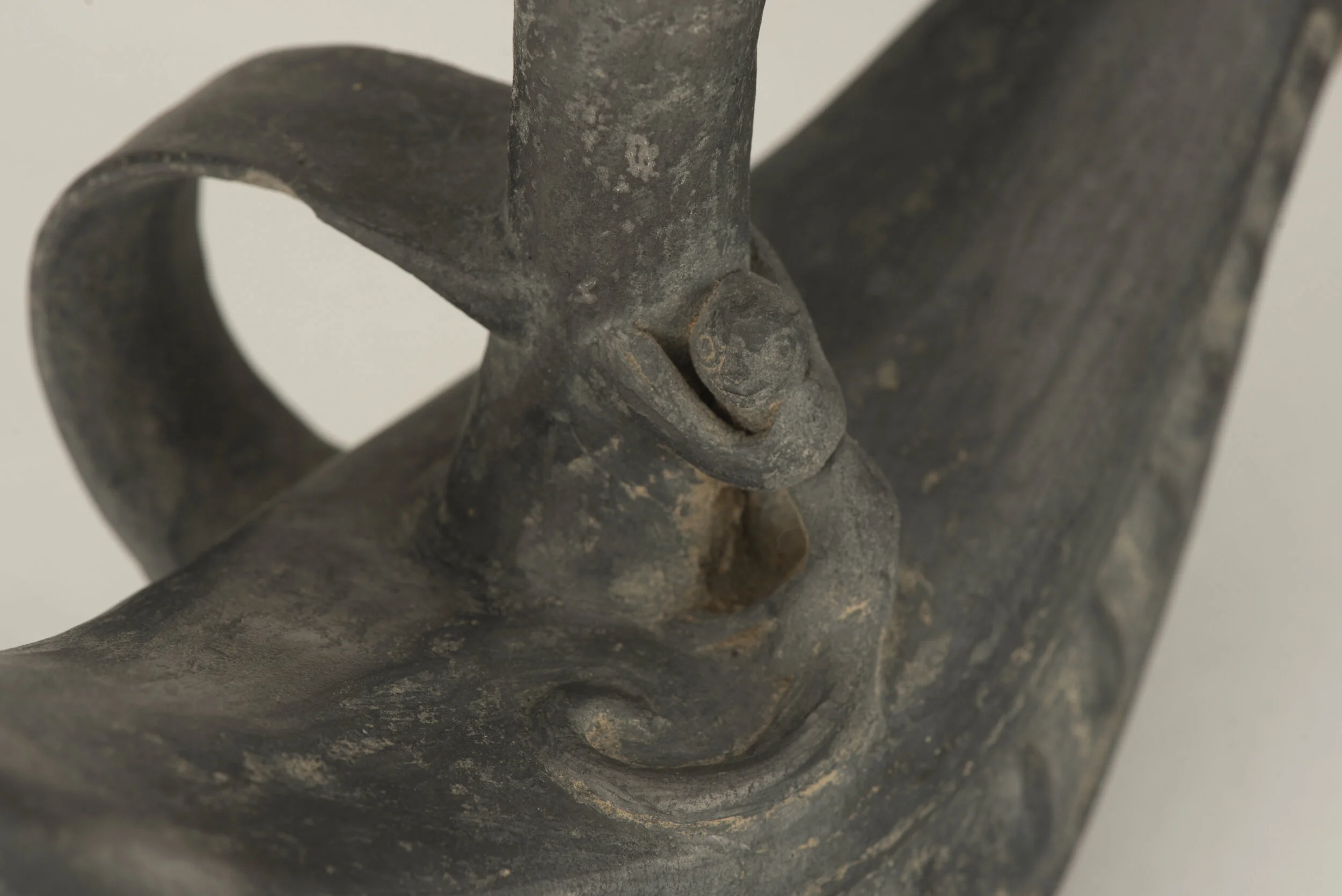New Exhibition at Logan Center Gallery Highlights Groundbreaking Collaboration with Field Museum
Image by Sarah Larson.
By Clare Austen-Smith
A fiberglass grid scattered with flower petals. A galvanized steel rod, partially taken over by a tree. A “playfully ornate pot” that seems to be talking.
That’s because it is.
Image by Sarah Larson.
Inside Harold Mendez: the years now, the exhibition currently on display at Logan Center Exhibitions, sits a pre-columbian vessel of the Chimú people from the Moche Valley in Peru. Well, almost. Scaled up and hollowed out to accommodate the speaker system that renders haunting dialogue throughout the exhibition, the Chimú funerary pot that rests in the Logan Center Gallery is a 3D replica of the original piece of pottery, which sits safe and sound in its temperature-controlled section of the Field Museum. The replicated ancient pot is both a captivating piece of art and the product of an exciting first time collaboration between Chicago’s Field Museum and the Logan Center.
This image shows one of the focus-stacked macro images Brown took of the original pot to capture the fine detail. Photo courtesy of JP Brown.
Shaped like a slice of papaya and almost looking like a smile, the spout forms in the middle of the pot and features a climbing figure of a small monkey, inviting the viewer to smile back. The pot likely has ritual significance in the funerary rites of the Chimú people; pre-columbian vessels like this were known to be part of the burial for people passing on to take with them to the afterlife, a usage intimately connected with Mendez’s practice. Through his re-creation of the pot and the addition of the speaker inside, Mendez “reconnects the object to the body through the voice, which continues to inhabit and haunt the pot,” said Katja Rivera, Assistant Curator at Logan Center Exhibitions.
A first-generation American born in Chicago to Colombian and Mexican parents, artist Harold Mendez often focuses his work on the body and funerary rites in the pre-Columbian era and uses “installation, photography, sculpture and text to reference reconstructions of place and identity.” That made the Field Museum a natural destination when Mendez began his research, given their extensive pre-Columbian collection. Put in touch with the museum by the Logan Center, Mendez was able to tour its South American wing. “The Field Museum was incredibly generous and accessible to us throughout this process,” said Rivera. It was through this tour that Mendez encountered the original Chimú pot.
This images shows the 3D environmental model prior to conversion to a printable model (basically, the output from photogrammetry, prior to making the 3D model manufacturable). Photo courtesy of JP Brown.
This collaboration between the Logan Center Gallery and the Field Museum is unique. In fact, it's “the first time a collaboration like this has happened” at the Field, according to JP Brown, Conservator for the Department of Anthropology and UChicago alumni. His work in conservation, archaeology, and 3D scanning is what made the replicated pot a possibility, as he has used the technology before in his own work. It might seem surprising that a venerable institution like the Field would be using technology often associated with maker spaces, but it’s incredibly helpful when considering archaeology, as well as making exhibitions open and exciting to the public. “When you get a million people a year through a gallery, the touching can be quite destructive, so in general we’re extremely reluctant to put original items in direct contact with the public,” said Brown, SM’05. But when you’re able to scan, fabricate, and then display something like, say, a mummy? Well, then you get an exhibition like Mummies, on display at the Field Museum in 2017, where visitors could handle exact replicas of original excavated objects from ancient Egyptian burial sites.
However, the purpose of the Chimú pot replica was different from that of the original. The golden rule of all art museums still applies—no touching—but the intentions of the object on display are very different. As a conservator, Brown is concerned with consistency between the original object and the replica. For Mendez, on the other hand, “what's important is that it's from an original object, but then he's going to distort it. So it's a starting point for him, whereas really for me, the original object is an end,” said Brown. But the process to recreate the Chimú pot wasn’t cut and dry. While the multi-step process, which can involve CT scans or photogrammetry, utilized to create such replicas can handle objects from “the size of your pinky nail up to elephants,” the Chimú pot’s burnished black color was particularly challenging, said Brown. “The fact that you can scan something in 3D doesn't mean you can download it and 3D print it.”
This image shows the camera positions for the photogrammetry - it required 453 images including 189 focus stacked macro images to capture all the details. Photo courtesy of JP Brown.
Despite the odds, the evidence of the successful collaboration sits in the Logan Center Gallery. “If you'd asked me at the beginning of the project, I would have said it was extremely difficult to impossible,” Brown said, “but in fact it ended up being just extremely difficult.” In the context of the exhibition, the presence of the pot adds a grounded reality to the piece and illuminates the ethos and motivations underlying Mendez’s work. “Mendez’s interest in pre-Columbian objects provided an exciting opportunity to partner with the Field Museum here in Chicago, who were incredibly generous with their time and enthusiastic about the project,” said Rivera. “We were especially thrilled to partner with the Field for the very first time as facilitating this kind of collaboration speaks to the mission of Logan Center Exhibitions to support interdisciplinary and ambitious work.”
Harold Mendez: the years now is on view until March 8 at Logan Center Exhibitions. Visit the exhibition.





